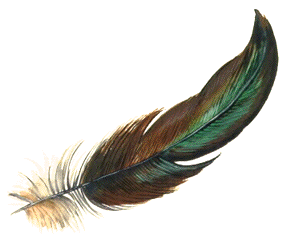
feather,
feathering -
In drawing and painting,
to feather is to blend
an edge so that it fades
off or softens. To feather is also to overlap
values and colors
in the manner of the overlapping
 feathers
of a bird.
feathers
of a bird.
"Feather-painting" and "feather-mosaic" are media and techniques in which feathers are used as pigments.
Feathers have been used as tools
of many sorts in the production of art. The shaft
(rachis) can be carved into the nib of a quill
pen. Both the quill (calamus) end and the barbed end have
been used in various other ways, most often to apply or spread
colors. Feathers have also been used whole or in parts as materials in many sorts of
artworks. Aboriginal peoples
of Peru and certain Pacific islands have produced fabulous costumes incorporating great numbers
of feathers in vivid colors.
colors.
Only birds produce feathers. For their size, they are light weight and strong. Many are waterproof. Often feathers can be repaired by stroking them from the base up, prompting the hooks on their barbs and barbules to make the barbs realign.
The Kiva Trading Company's American Indian Symbol Dictionary explains that in American Indian culture, �gfeathers, depicted in many, many ways, are symbols of prayers, marks of honor or sources of ideas. They represent the Creative Force, and are taken from birds connected with the attribute for which they might be utilized."
"Feather" can also refer to something with a pattern that is feather-like. Anything that is feather-shaped can be called pinnate.
In etching, feathering is to stir or move around the bubbles in the acid with a feather, brush, or pipe cleaner.
Examples of feathers in art:

Albrecht Dürer (German, 1471-1528), Wing of a Roller, 1512, watercolor and gouache on vellum, 20 x 20 cm, Graphische Sammlung, Vienna. See Northern Renaissance.

Juan Baptiste Cuiris (Mexico, Michoacán,
Pátzcuaro), Feather Picture of the Virgin Mary, c.
1550/80, hummingbird and parrot feathers on paper,
wood; signed,
25.4 x 24.3 cm, Kunsthistoriches Museum, Vienna. See iridescence,
luminosity, and Mexican
art.

China, Chuba, Qing
dynasty (1644-1911), 17th century, cut velvet with patterned wefts
of multicolored silks, gold-wrapped
silk, and peacock-feather filaments, width
55 inches (139.7 cm), Metropolitan Museum of Art, NY. See Chinese art
and costume.

Australia, Torres Strait, Mabuiag Island,
Torres Strait Islander people, Mask, 19th century, turtle-and clam shell,
wood, feathers, resin,
seeds, paint, fiber, width 25 inches (63.5 cm), Metropolitan
Museum of Art, NY. See mask.

Probably Nakota, Yankton Sioux, Northern
Plains, Shield, late nineteenth
century, buffalo rawhide, native tanned leather, calico cloth,
hawk feathers, pigment,
diameter 20 1/16 inches
(51.0 cm), Cincinnati Art Museum, OH. See American
Indian art.

Africa, Ivory Coast, Senufo peoples, Mask, 19th-20th century, wood,
horn, fiber, cotton, feather,
metal, sacrificial material,
height of mask 14 1/8 inches
(35.9 cm), Metropolitan Museum of Art, NY. See African art.
Also see caduceus, debubblizer, marbling, mosaic, panache, and sfumato.
![]()

https://inform.quest/_art
Copyright © 1996-![]()